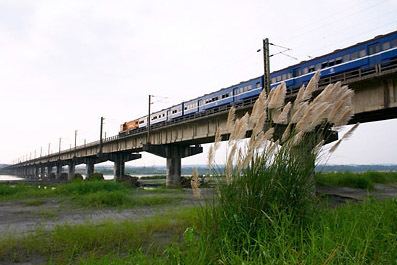Total 1,691 km (1,051 mi) Electrified 1,372 km (853 mi) | Double track 1,210 km (750 mi) High-speed 339 km (211 mi) | |
 | ||
Main 1,435 mm (4 ft 8 ⁄2 in) standard gauge | ||
Rail transport in Taiwan consists of 1691.8 km (as of 2015) of railway networks. Though no longer as dominant as it once was, rail transport is an extremely important form of transportation in Taiwan due to high population density, especially along the densely populated western corridor. In 2011, over 863.4 million passengers used the rail systems in Taiwan, averaging 2.36 million passengers per day.
Contents
The railways of Taiwan include conventional rail, rapid transit systems, and high-speed rail, as well as specialized railways for tourists and industry. Taiwan Railways Administration is an associate member and Taiwan High Speed Rail is an active member of the International Union of Railways (UIC), even though Taiwan does not have state membership.
Rail transport was introduced to Taiwan in 1891 during its late Qing era. Push car railways were brought to Taiwan during Japanese rule and were in general service from 1895 to the late 1940s.
The island of Taiwan is the only part of the present-day Republic of China to have rail transport (i.e., none of the small offshore islands—Kinmen, Matsu Islands, Pratas Islands, Penghu or Taiping—have rail transport).
Intercity railways
There are two operators that provide intercity services in Taiwan:
Rapid transit
With the increasing urbanization of Taiwan, several urban rapid transit systems have been constructed with several more being planned.
Industrial and tourist railways
Originally built for the transportation of industrial products, these railroads have become tourist attractions.
Track gauge
The earliest railway in Taiwan was completed in 1893 under the auspices of Governor Liu Mingchuan during the Qing dynasty (see Taiwan Railways Administration§History). Since then, major railways in Taiwan have followed the 3 ft 6 in (1,067 mm) gauge standard. The Hualien–Taitung Line was once 2 ft 6 in (762 mm), but since 1982 it has been converted to 3 ft 6 in (1,067 mm), while the Alishan Forest Railway and the majority of Taiwan Sugar Railways are still 2 ft 6 in (762 mm) railways. The Taipei Metro, Taiwan High Speed Rail, and Kaohsiung Mass Rapid Transit all use standard gauge track.
Cultural
Because of the Taiwan's extensive rail network (including many now defunct industrial narrow gauge lines which provided passenger service to rural areas), railways in Taiwan often have a romantic connotation, especially amongst the older generation who remember growing up when rail travel was the primary means of transportation between cities in simpler (and less prosperous) times. Many remember leaving their hometowns to attend school in far away cities by train or leaving via train to perform their compulsory military service. This nostalgia has been capitalized upon in recent years through the introduction of various items such as "nostalgia railroad ekiben" (懷舊鐵路便當), claimed to be authentic copies of the box lunches that were once served aboard trains.
There is also a sizable network of railway fans in Taiwan which has increased with the recent trend of Taiwanization.
